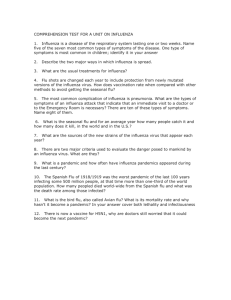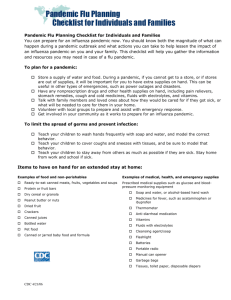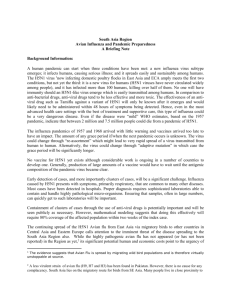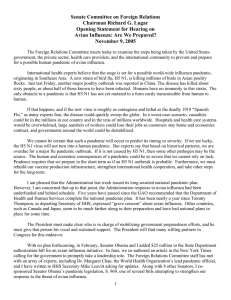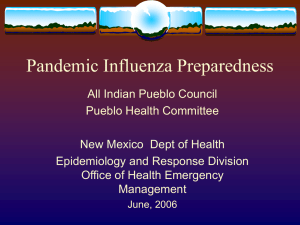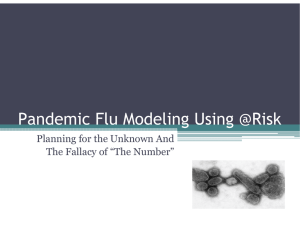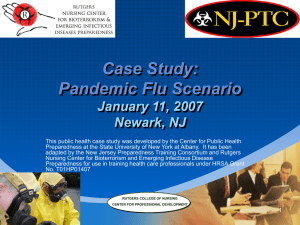PowerPoint Presentation - Knox County Government
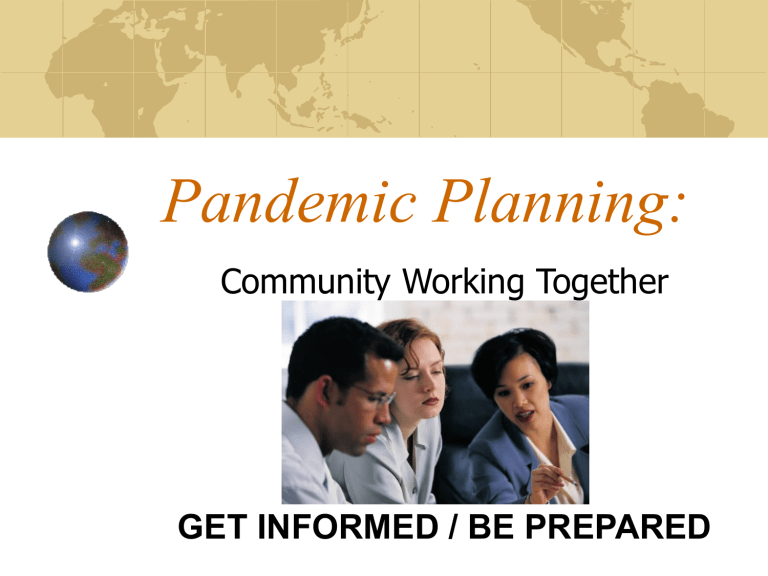
Pandemic Planning:
Community Working Together
GET INFORMED / BE PREPARED
Objectives
Review of Influenza Virus and Illness, H5N1 avian influenza (“bird flu”)
Pandemic Influenza Planning assumptions and principles
National (Health and Human Services, or HHS)
Tennessee
Knox County
Local Pandemic planning
Individual Pandemic planning
Local Pandemic Planning
Six groups
Faith based/Community
Healthcare
Business
Media
Mortuary
Schools/daycare
You are here*
Why Plan?
Evidence suggests… all communities would be severely impacted when a civilian disaster produces more than 120 casualties.
Therefore, >120 casualties considered a
MCI - Mass Casualty Incident.
major
In MCI, without Internal Disaster planning, estimated 40% business will fail.
For social cohesion in a crisis to occur, planning and communication need to occur now.
The Pandemic Influenza Cycle
Rapid transmission with worldwide outbreaks; multiple waves of disease over a 2 year period.
Occurrence of cases outside the usual season.
High attack rate for all age groups, with high mortality rates, esp for young adults
Cycles 10-40 years. Last pandemic was mild,
1968 (35 years ago)
Situation Report: Avian Influenza
Widespread prevalence in migratory birds; broad host range
Continued outbreaks among domestic poultry
Mammalian infection (cats, pigs, etc.) - lethal
Virus is evolving
Sporadic human cases (>190 reports to date)
•
Most in young and healthy, Case-fatality 50%
•
Rare person-to-person transmission
H5N1 Influenza and Pandemic Preparedness
Avian Flu not yet Pandemic Flu, but current outbreaks for H5N1 Avian Flu in poultry and birds are the largest that have ever been documented.
7
Will H5N1 become the next pandemic?
Impossible to know if or when
If not H5N1, then another will come
The prudent time to plan is now
HHS Objectives:
Pandemic Planning and Response
Primary objective :
Minimize sickness and death
Secondary objectives :
Preserve functional society
Minimize economic disruption
There is not complete consensus on the proper order of these objectives
Assumptions about Disease
Transmission
No one immune to virus; 30% of population will become ill
Most will become ill 2 days (range 1-10) after exposure to virus
People may be contagious up to 24 hours before they know they are sick
People are most contagious the first 2 days of illness
Sick children are more contagious than adults
On average, each ill person can infect 2 or 3 others (if no precautions are taken)
Medical Burden in Tennessee (pop. 6 million) (HHS Plan Estimates)
Characteristic Moderate
(0.2%)
Severe
(2%)
Illness (30%) 1.8 million
Outpatient Care 900,000
1.8 million
900,000
Hospitalization 17,300
ICU Care 2,575
Mechanical
Ventilation
Deaths
1,300
4,180 (0.2%)
198,000
29,700
14,850
38,060 (2%)
*HHS recommends that states plan for severe scenario
Medical Burden in Knox County
2005 Knox County Population est. 396,741
Characteristic Moderate
(0.2%)
Severe
(2%)
Illness (30%)
Outpatient care
Hospitalization
ICU
(15% hosp pts)
Mechanical ventilators
(50%
ICU pts)
Deaths
119,000
59,500
1,190
180
90
240
119,000
59,500
11,900
1,800
900
2,380
Preparing for a Pandemic in Knoxville
Federal Plan: Local and Self-reliance is key
Local groups to develop Internal Disaster Plan
Surveillance
Communications
Infection Control
Occupational Issues
Vaccine/Antiviral access
Public Health responsibility to educate and facilitate PanFlu planning
Preparation by families and individuals essential
Influenza Virus:
How it spreads
Close contact (<6 feet) with sick person who is coughing or sneezing
Touching a surface contaminated by respiratory secretions and getting the virus into mouth, nose or eyes.
Community Disease Control:
Early Stage Isolation and Quarantine
Initial Objective: slow spread of disease
Isolation vs. Quarantine
Legal measures possible but will rely on voluntary cooperation
Housing, health care, psychological, spiritual, food needs must be met for those on isolation/quarantine
Once beyond initial cases, shift strategy to
“stay home when you are sick”
Influenza Containment Strategy:
Community Response
Basic Activities
Surveillance; quarantine of early cases
Public information and education
Promote “respiratory hygiene” and hand washing
Enhanced Activities
Focused measures to increase social distance
Community-wide measures to increase social distance
Community Disease Control:
Community Wide Measures
Reduce Social Contact :
Canceling large gatherings, mass transit, schools
Decision based on location of flu activity:
Outbreak not local: gatherings >10,000 cancelled
Outbreak in local/neighboring county: >100
School closings determined by State
Commissioner of Health/Board of Education.
Vaccine or Antivirals??
Flu Vaccine
Production minimum month process:
6
Growing eggs (93 million!)
HHS priority groups
1. Military and
Vaccine manufacturers
2. Healthcare workers with direct patient care
3. Persons at highest risk for complications
Two doses needed for protection
Tamiflu
Anti-viral agent, currently in short supply
Could be used in one area of world to contain first human outbreak
Resistance described
Should be used within
48 of infection
HHS priority groups: military and hospitalized patients
Tamiflu ≠ Preparedness
Guidance for Planning
Because resources will be limited…
Contingency planning should include:
Planning for absenteeism: ~40%
Hygiene products and education in the workplace
Supply shortages
Home offices for critical personnel
Sick leave policies compatible with state recommendations
Planning to be away…
Plan for childcare in the event schools close
Arrangements made for eldercare, pet care
Discuss/develop plan with employer how you might work at home
Guidance for Personal /Family
Planning
Personal protection:
Hand hygiene and respiratory etiquette
Surgical masks: proven effective for droplet precautions
Pneumococcal vaccination of those for whom it is recommended
Stockpiling: One to three week essential water, food, supplies, medicines
Surveillance Here at KCHD
A traditional influenza responsibility of the Department of Health:
Sentinel health care providers
ER visits
School absenteeism
911 calls
CDC is planning additional national surveillance activities: hospitals and states will assist upon request
For those at work:Surveillance
– Develop screening symptoms for employees with flu-like
Develop sick leave policy specific for panflu
Determine when ill employee may return to work
Internal and External
Communication networks
Detailed communications planning needed:
Internal- Ensure employees know panflu policy, communications plan, their specific role, esp in surge capacity/
External- Point of contact with Health Department
Access to Public Health education via media, internet, phone bank
Coordinate with like organizations to develop/coordinate emergency plans
Communicate with other organizations affected by yours
Infection Control
Hand Hygiene
Frequent washing
60%-95% alcohol-based sanitizer
Environmental cleaning
1:10 bleach solution
EPA registered disinfectant
Gloves & surgical masks. Face shields/goggles for specialized procedures
Workforce Support
Psychological and physical strain on personnel responding in emergency situation
Psychological stress for families
Plan for your staff to have adequate
Sleep
Food
Access to psychological and spiritual support
Resources
PandemicFlu.gov
CDC.gov/flu/avian www.nyhealth.gov
Knoxcounty.org/health
Knoxpanflu@knoxcounty.org



